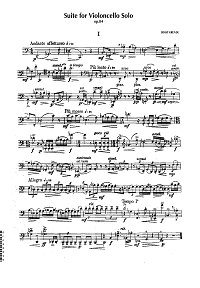Krenek - Suite for violoncello solo op.84
Krenek - Suite for violoncello solo op.84. You can download the PDF sheet music Krenek - Suite for violoncello solo op.84 on this page. Ernst Krenek composed his five-movement Suite for Violoncello op. 84 in 1939. Its second Movement, marked 'Adagio', exemplifies the modern cantabile style of the day, while the central Movement (Allegretto) represents his own personal way of coming to terms with principles of linear counterpoint put forward by Ernst Kurth, a theoretician who had exerted a strong influence on him. Within the highly restricted compass of the Suite the listener encounters the apparently polyphonic effect which Kurth had pointed out to his pupil in the solo suites of Bach. It is an impressive work, brought 'molto liberamente' to a close by an almost aggressive waltz (Andantino scherzando) and a seemingly improvised 'Andante' which harks back to the opening movement, thus 'squaring the circle' created by the composer through the synthesis of an arc-shaped layout and a sequence of loosely-connected movements.
To download PDF, click the "Download PDF" button below the appropriate sheet music image.
To view the first page of Krenek - Suite for violoncello solo op.84 click the music sheet image. |
| PDF format sheet music |
|
|
|
Cello part: 4 pages. 3312 K
|
|
 |
|
|
|
| Download PDF (14.99
€) |
|
|
|
|
Ernst Krenek (1900-1991) studied with Franz Schreker in Vienna from the age of sixteen and evidently found his teaching so congenial that he followed him to Berlin on Schreker's appointment as director of its School of Music. Once there, however, a curious estrangement developed between them. Krenek fell in with an intellectual circle for whom Bach, Beethoven and Schubert played a central role, and when the budding composer had read Ernst Kurth's Principles of Linear Counterpoint the stage was fully set for conflict.
Without Schreker's approval, Krenek smuggled his first string quartet op. 6 into the Nuremberg Festival of the German Musicians' Association, where it was given a successful first performance; only later did he justify his breach of trust by claiming that he had 'distanced himself in a very short time from his teacher's late-romantic, quasi-expressionistic style'. In so doing, of course, he became ensnared in self -contradiction: in his Selbstdarstellung (Self -Portrait), when he cites Schreker's maxim that a composition should be surprising, unique, and free from predictable, old-fashioned, traditional features' the question inevitably arises as to why so individual a work as this string quartet, which fulfilled all Schreker's criteria, should in any way have displeased him.
This turn of events led Krenek to embrace dodecaphonic composition, perhaps partly in his desire to become accepted by Schoenberg and his circle. John Stewart writes in his biography of Krenek that Webern was the only one to have made the 33-year-old composer feel he had achieved this ambition. Schoenberg and even Berg, who was in other respects friendly towards him, never saw Krenek in this light, and others, such as Zemlinsky, were at pains to make it clear to him that though he had adopted twelve-tone technique he was still an outsider.
In the USA, to which he was forced to flee from the political turmoil of 1938, he eked out a dismal existence, not even managing to obtain any teaching work, which would have guaranteed him at least a minimal income. On the one hand steeping himself in the supposed secrets of Johannes Ockeghem and on the other composing his main vocal work, a setting of the Lamentations of the Prophet Jeremiah, he wrote to the conductor Dimitri Mitropoulos asking him for support to help him to gain a teaching post in Minneapolis. The reply he received was remarkable. Evidently Mitropoulos's admonition did not go unheeded. Krenek was soon at work composing his variations on the American pseudo-folksong, in which he found himself confronted with a diatonic theme and having to compromise with his strict twelve-note principles.
|
|